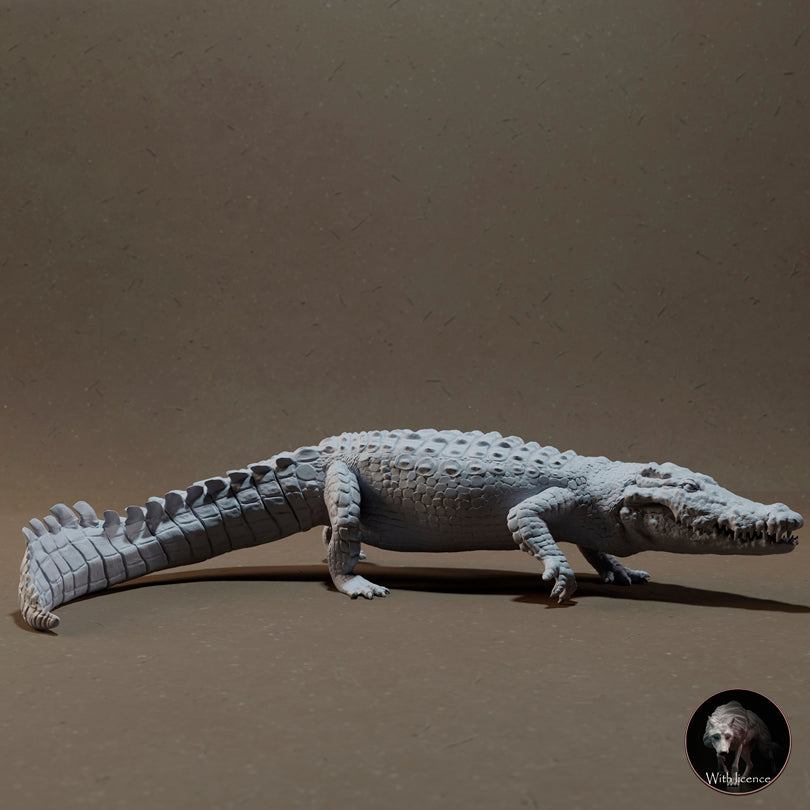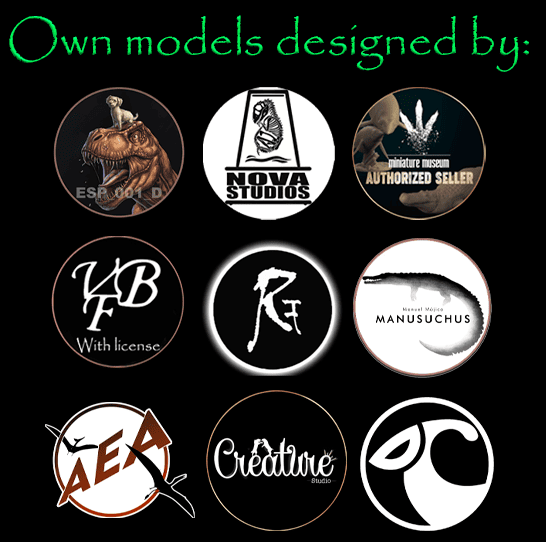



Nile crocodile
Do you want another scale?
Contact us and we will make it possible!
How will you receive your replica?
In the unprimed and primed variants, you will receive the complete replicas except for the large models, where you will receive an assembly kit.
In the hand-painted variant, the replicas will be delivered complete.
How does the painting service work?
We created a private chat for you where you will have direct communication with our painter , being able to choose your preferred color schemes and follow the hand painting process closely.
Pairs well with

Nile crocodile
If you have any questions, you are always welcome to contact us. We'll get back to you as soon as possible, within 24 hours on weekdays.
Shipping Information
Visit our shipping policy page to find all the information.
Customer Support
Give us a few details and we’ll offer the best solution. Connect by chat or email.
We are available 24/7.
FAQ’s
Visit our FAQ's page to find answers to common questions.
Contact Us
We'd love to hear from you. We are here to help. Visit our contact page to send us a message.
Product details
The Nile Crocodile (Crocodylus niloticus) is one of the largest crocodile species in the world, with an average length of between 4 and 5 meters and a weight of around 225 kg. Some exceptional specimens can exceed 6 meters in length and weigh more than 900 kg. Males are slightly larger than females and have a longer and broader snout.
The natural habitat of the Nile Crocodile is extensive, found across much of sub-Saharan Africa, from Ethiopia and Sudan to South Africa, in a variety of aquatic environments, including rivers, lakes, swamps, and wetlands. These reptiles are semi-aquatic animals and spend much of their time in the water, but they can also be found basking on the shores and on dry land.
Nile crocodiles are top-of-the-food-chain predators, capable of hunting a wide variety of prey, including fish, reptiles, birds, mammals, and even other crocodiles. They are highly resilient and adaptive animals that have managed to survive on Earth for over 200 million years.
However, in the Anthropocene, the Nile crocodile has been affected by a series of threats caused by human activity. Poaching for their skin and meat has significantly reduced crocodile populations in some locations, while natural habitat degradation due to dam construction, agricultural expansion, and urbanization has also adversely affected their survival.
In addition, Nile crocodiles are also affected by water pollution and overfishing, which reduces food availability for them and can negatively affect their health.
Despite these threats, some conservation efforts have helped maintain Nile crocodile populations in some areas, including creating protected areas and implementing regulations to limit hunting and trade in their skins. Additionally, education and public awareness about the importance of conserving this species and its natural habitat can help ensure its future survival.
The Model Pose represents a specimen of a Nile Crocodile walking near the river bank.
Approximate measurements of the Nile Crocodile:
- Scale 1:24 - 121 x 82 x 28 mm H
Information about aftershocks
Collector's item ; Hyper-realistic replica, highly detailed and with a high degree of scientific precision.
Made to scale, prototyped in resin and with a scenic base in most of the models offered. If you like miniatures, both for collecting and for painting, we offer you a wide variety of scale replicas; All of them related to dinosaurs, extinct prehistoric fauna and current fauna.
So if you love dinosaurs and animals as much as we do, this is your favorite store to collect and paint them :)
We are authorized distributors of all the replicas and figures we offer. We use 3D printers with 8K - 14K resolution, and high-quality resins with additives to improve hardness and flexibility, thus offering replicas of impeccable quality.
Different scales will be used to make the replicas (depending on the size of the species), although we are open to making other suggested scales upon request as long as they fit in our printing trays, for which you will have to contact us via email and request the required size.
Replicas are supplied with the option of airbrush priming in dark grey. If you require another colour, please let us know which one you prefer in the box with special instructions for the seller. Without priming, we do not guarantee that the resin will accept paint.
We also offer the option of choosing a professionally painted replica, which is agreed upon throughout its development with the painter, through a private chat available.
Complete replica (one piece): We supply complete replicas in those models that are small, and models that are medium, large or not very bulky, will have the prerogative of being presented as a complete replica or assembly kit as the case may be.
Complete replicas will be supplied separately from their base.
Replica assembly kit: We supply replicas whose models are large, very large or bulky, only with this option.
The indicated replicas (generally composed of base, head, body and tail) will come prepared for the subsequent assembly that will be required by the client, by sanding, putty, adhesive or technique chosen by the client.
All replicas are thoroughly inspected before shipping and will be carefully packaged to prevent damage during transport.
Information about the models
The poses of the models aim to represent each character in the most scientifically viable way, thus revealing the life and customs of prehistoric and modern fauna.
Each character has its own personality and develops in different life scenarios; birth, adolescence and play, hunting, feeding, fighting, courtship, death and many other scenes from their daily life, always from the creative perspective of their designers.
Handmade
All orders are individually prepared on the cutter for subsequent prototyping, obtaining a resin part that will require post-processing by manual and ultrasonic cleaning, support removal, ultraviolet curing, labeling and packaging.

We are authorized distributors
We offer both our own physical replicas and those that have been modeled by many of the best 3D designers, in order to offer you the greatest possible variety.
Frequently Asked Questions
If you have any questions about products, orders or shipping, please read our FAQ page to learn more.
